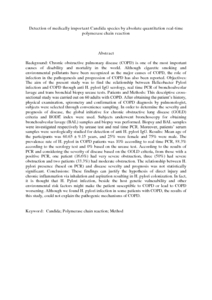Citation
Than, Leslie Thian Lung and Chong, Pei Pei and Ng, Kee Peng and Seow, Heng Fong
(2015)
Detection of medically important Candida species by absolute quantitation real-time polymerase chain reaction.
Jundisphapur Journal of Microbiology, 8 (1).
art. no. e14940.
pp. 1-6.
ISSN 2008-3645; ESSN: 2008-4161
Abstract
Background: Chronic obstructive pulmonary disease (COPD) is one of the most important causes of disability and mortality in the world. Although cigarette smoking and environmental pollutants have been recognized as the major causes of COPD, the role of infection in the pathogenesis and progression of COPD has also been reported. Objectives: The aim of the present study was to find the relationship between Helicobacter Pylori infection and COPD through anti H. pylori IgG serology, real time PCR of bronchoalveolar lavage and trans bronchial biopsy urease tests. Patients and Methods: This descriptive cross-sectional study was carried out on 60 adults with COPD. After obtaining the patient’s history, physical examination, spirometry and confirmation of COPD diagnosis by pulmonologist, subjects were selected through convenience sampling. In order to determine the severity and prognosis of disease, the global initiative for chronic obstructive lung disease (GOLD) criteria and BODE index were used. Subjects underwent bronchoscopy for obtaining bronchoalveolar lavage (BAL) samples and biopsy was performed. Biopsy and BAL samples were investigated respectively by urease test and real time PCR. Moreover, patients’ serum samples were serologically studied for detection of anti H. pylori IgG. Results: Mean age of the participants was 60.65 ± 9.15 years, and 25% were female and 75% were male. The prevalence rate of H. pylori in COPD patients was 10% according to real time PCR, 88.3% according to the serology test and 0% based on the urease test. According to the results of PCR and considering the severity of disease based on the GOLD criteria, from those with a positive PCR, one patient (16.6%) had very severe obstruction, three (50%) had severe obstruction and two patients (33.3%) had moderate obstruction. The relationship between H. pylori presence (based on PCR) and disease severity and prognosis was not statistically significant. Conclusions: These findings can justify the hypothesis of direct injury and chronic inflammation via inhalation and aspiration resulting in H. pylori colonization. In fact, it is thought that H. Pylori infection, beside the host genetic vulnerability and other environmental risk factors might make the patient susceptible to COPD or lead to COPD worsening. Although we found H. pylori infection in some patients with COPD, the results of this study, could not explain the pathogenic mechanisms of COPD.
Download File
![[img]](http://psasir.upm.edu.my/37014/1.hassmallThumbnailVersion/Detection%20of%20medically%20important%20Candida%20species%20by%20absolute%20quantitation%20real.pdf)  Preview |
|
PDF (Abstract)
Detection of medically important Candida species by absolute quantitation real.pdf
Download (153kB)
| Preview
|
|
Additional Metadata
Actions (login required)
 |
View Item |

